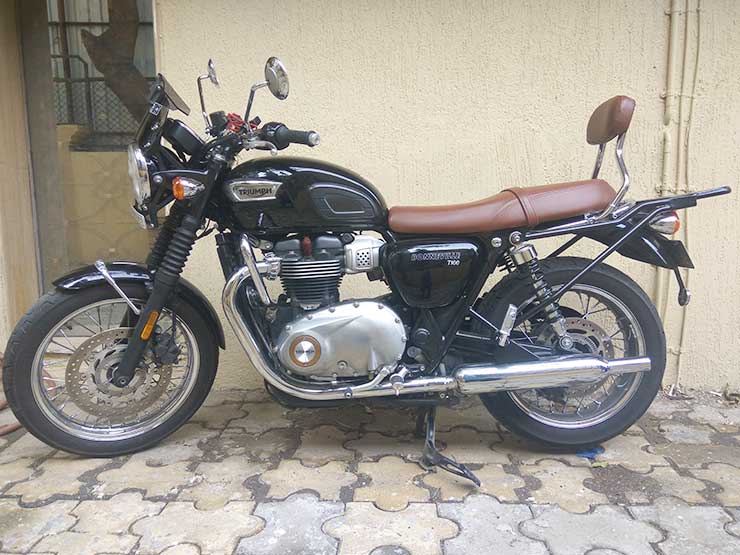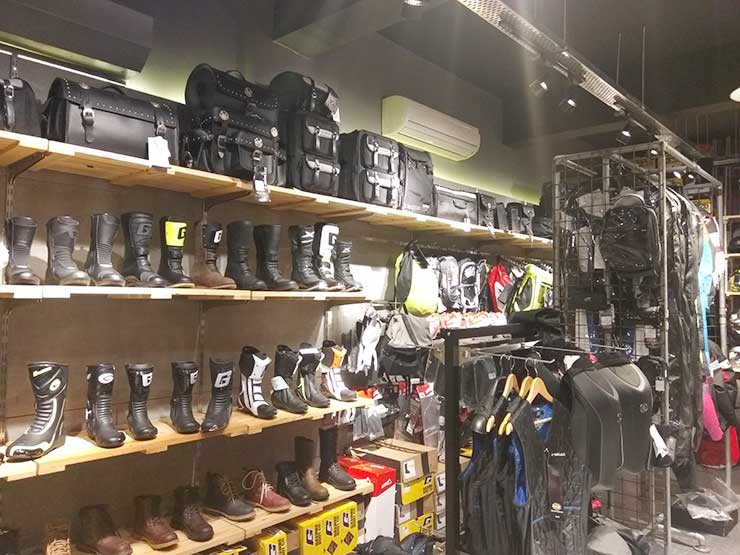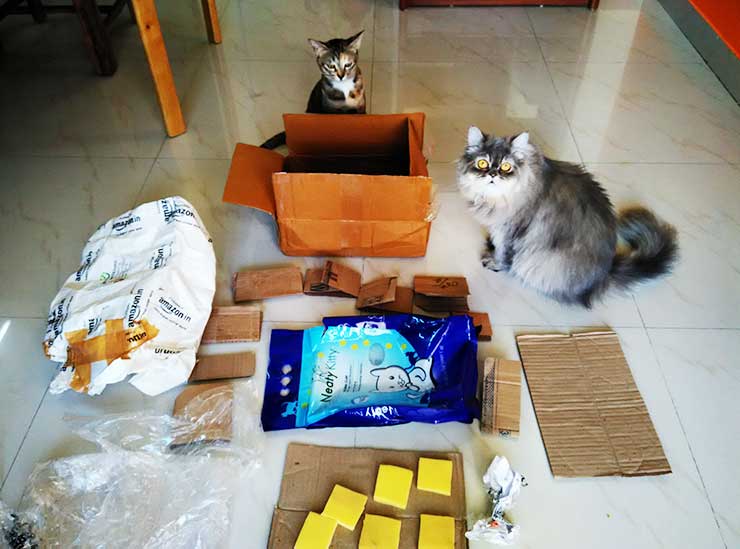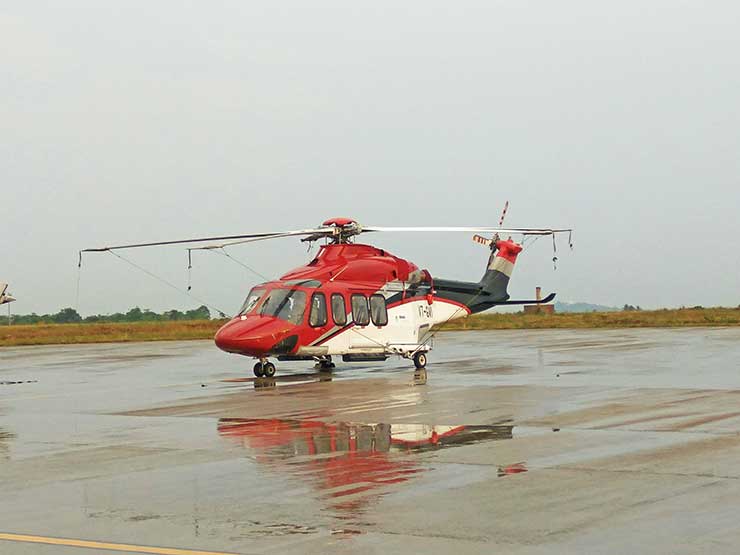
Recently, I went bike-accessory shopping with my friend and fellow aviator Kinny. He is busy pouring money on an imported beast called Triumph Bonneville T-100 he acquired six-months ago. His accessory shopping bill is scaling new heights but he still maintains his trademark beatific smile. He cautioned me not to look at the price tag of items in the showroom. An Indian proverb “Hema Malini se shaadi karke lipstick ka price nahi poonchte” comes to mind (“Don’t ask for the price of lipstick after marrying Hema Malini”, a yesteryears Bollywood heroine).
What left me even more surprised was the fact that I spent two hours in ‘Lazy Ass Bikers’ (LABS), a superbike accessory shop in Mumbai, while Kinny tried on five pairs of riding boots (he ultimately bought the one he had already zeroed-in sitting in his room through the store’s online App).
Replace Kinny with wife, and motorbikes with silk sarees or Hidesign handbags, and both my blood pressure and temper would have gone through the store’s roof in under 20 minutes.
Why was I the epitome of calm & complete acceptance in an imported superbike showroom with Kinny while I would surely have morphed into ‘angry young man’ if I was shopping with Madhuri in Westside? (an Indian enterprise from Tata Sons)
On the shelves of LABS sat riding helmets that cost as much as an average Indian family’s monthly income, gloves more expensive than my yearly uniform allowance, boots that cost an arm and a leg, and biking jackets that will wickedly cover the gaping hole it burns in your pocket.
But all this is par for course because you bought a 10-lac, imported superbike. I asked the showroom owner couple of questions.
How much of the stuff here is imported? Pretty much everything, he said.
How much of this stuff is designed for Indian conditions? Nothing is designed specifically for India, but it will cope fine, he admitted. Outside the showroom, buses, cars, two wheelers, hawkers and livestock jostled for space on pothole-ridden roads in 33ºC with 87% humidity.
Then why these things can’t be made here in India? Why import biking accessories…it’s not rocket science, right? I posed.
Quality? Aw, c’mon…these things are most likely manufactured in some third-world country, exploiting cheap labour.
Not enough market for these items? Then why are we even here?
How about making them here in India and exporting to rest of the world – a win-win situation for all. Why not?
By now my Caffè latte was getting cold and I was getting nowhere. A tentative hypothesis was that Indians are unlikely to trust the quality and safety standards of such equipment if manufactured in India.
Caveat Emptor
Ah, that sounded familiar! Caveat emptor. If it’s imported we take quality for granted. If it’s indigenous, we start suspecting the pedigree. This mentality hasn’t changed 71 years after independence. And it extends to industries as progressive as aerospace and defence (A&D).

I had questioned in an earlier post why we continue to import pet accessories like it is some spare part for cryogenic engines. My Indian cat feasts on Royal Canin and poops on imported cat litter while the government is still trying to eradicate open defecation in India. How to make sense of this? Even my cats can’t.
There was a time when the British, through East India Company, carted away shiploads of Indian raw material, turned them into finished goods and dumped them back here, leaving millions of Indian artisans – far ahead of the world then – in penury. Shashi Tharoor’s latest book ‘An Era of Darkness’ (written after his famous Oxford speech) documents it comprehensively.
And now you can’t even blame the Monarchy. They Brexit when it ain’t broken
My limited scope for this write-up is aerospace manufacturing: making planes, helicopters & their spare parts in India. With ‘Make in India’ becoming the order of the day for almost all defence equipment, it is time we confront some bad habits. The Indian buyer and industry both must change their ways if A&D manufacturing has to succeed under the new ‘Make in India’ paradigm.
Let me explain with some contemporary anecdotes.
Get the Big Decisions Right
The start point for all A&D acquisitions or developmental projects is laying down staff requirements (SR). This is the very first step where we often go wrong. The present system, at least in the navy, is borrowed from the shipbuilding model which allows scope creep, alterations and iterations late into the project without risk of project floundering. But unlike aerospace, shipbuilding is relatively free of inter-service jostling. While a lot of manhours go into making SRs, the biggest decisions are often wrapped up without a careful eye on the future. Let me explain.

In one fell swoop, the Indian Navy rejected single-engined (SE) helicopters as an option for the future. While arriving at this momentous decision, was a detailed study undertaken of safety and incident/accident statistics single versus twin/multi-engined helicopters world-over? Were other risk-mitigation options considered? Was the impact of such a decision on performance, training, operational costs, crew requirements, ship-fit and joint operations considered? Was there any lateral knowledge osmosis from commercial applications of SE helicopters? Ditto for some other key decisions like wheel or skid, retractable versus non-retractable undercarriage etc. Often, pet peeves and ‘halo effect’ play a role in shaping such decisions.
Why not let plain logic, analyses and the scientific method rule? In aviation, seat-of-pants decision making can lead to spatial disorientation, especially when you have poor visibility on what lies ahead.
Only time will tell if the decisions were right. As of now, one thing is sure. We have parted ways with ongoing projects of other two services and foreclosed many options.
Raise the Bar for Quality
Recently, Mumbai saw a sudden spell of pre-monsoon showers. On pulling in to the dispersal with a modern, state-of-art (read imported) helicopter and applying brakes, a few drops of rainwater collected in some overhead cavity emptied itself onto the fuel panel of the aircraft. Nothing spectacular happened. The crew wiped it off, reported the matter to maintenance and walked to the crew room. Did that one incident cast a lifelong shadow on the aircraft or its quality? No sir. Nobody in India casts aspersions on machines manufactured by Airbus, Bell Flight, Sikorsky, Leonardo and such like. They have earned their place through quality that matches global standards, not local.
In India, starting from a staple pin to warships, a wide spectrum of quality is available. There is no baseline, inviolable benchmark for quality. A decade ago, I didn’t want to spend on a Blackberry. So I settled for a cheap imitation masquerading as Blackcherry. It was put to test one afternoon when I carelessly left it on my beanbag. Our pet cat liberally sprayed it with urine and ‘Destroyed in Seconds’ followed while I was busy watching Discovery channel.

The NUH & NMRH of the future should be benchmarks of quality other countries aspire for. This will not happen if the service and industry collude to water down specifications. Aim high, much higher than what the customer wants. But carefully identify the line where science ends and science fiction begins.
Bridge the Trust Deficit
I have seen, touched and flown a fairly wide spectrum of helicopters. Russian, European, American, of all sizes and shapes. Rainwater proofing (RWP), for instance, has been a bane of helicopters that shake, rattle and roll much more than their FW counterparts. Some manufacturers have been more successful than others in licking this problem. Success is relative.
Our indigenous ALH Dhruv has been under constant scrutiny for RWP. If a similar drop of rainwater had fallen on the ALH fuel panel, we would have created a furore big enough to set the project back by a few years. Strengthening RWP of the ALH has been a slow process with many setbacks because our inherent suspicion towards Indian quality weighed heavily in our assessments. To make matters worse, band-aid fixes were implemented by the OEM leading to a self-defeating cycle of mistrust, endless mod-leaflets and disappointments galore.
By no means am I suggesting that a leaking chopper is acceptable. Just like my friend wouldn’t like his $200 riding boots chafing on the Bonneville’s gear shift lever, I wouldn’t like my million-dollar eggbeater to leak.
I want the same reassurance of quality; regardless of whether I am strapping into an NH-90 NFH or an ALH Dhruv. Am i asking for too much?
But our generosity when it comes to taking a view on shortcomings when they come with imported goods is intriguing. Perhaps, this stems from a deep-seated trust deficit between customer and manufacturer when both are Indian. Hence the need to ‘make Indian’ but ‘design global’ and ‘exceed’ rather than ‘match’ expectations.
Project Ownership & Leadership
Lockheed Martin’s Skunk Works that has won seven Collier Trophies delivered the SR-71 ‘Blackbird’ with “small empowered teams, streamlined processes and the culture that values the lessons learned when you are bold enough to attempt something that hasn’t been done before”.
Our maiden indigenous aerospace babies ALH & LCA grew up in a big (dis) joint family with myriad idiosyncrasies and diverse, often contradictory requirements. There was no Kelly Johnson or a person of his stature. Sadly, in our forays into indigenous D&D of aircraft and helicopters, we have violated almost all of Kelly’s 14 Rules & Practices.
LCA project had Kota Harinarayana who could hold his own. But even his time was limited and nobody filled that void. Designers, overseeing teams and decision makers ran amok with the ALH program to such an extent that a few decades later, Navy was left holding a helicopter that wouldn’t get inside a ship’s hangar without breaking some parts.
As a direct consequence, what could have been ‘world-class’ left its own constituency confused and disoriented. HAL, nay India as a nation, lost an opportunity to lift itself out of the morass it finds itself today in matters aerospace. No export of the ALH has been fully successful to date. That is the ultimate testing ground and there we failed. Is it lack of talent? Absolutely not.
Nurture Talent
In my time with the industry, I have seen up close young, bright minds, eager to ‘make a dent in the universe’ like Steve Jobs. Working in aerospace design and development is a dream many young Indians will die for. But the entry barriers are huge, quality benchmarks are nebulous, you need chacha batija connections to get inside. Once you join a public sector A&D monolith, a safe, secure job awaits you. Unions protect the workers’ interests while middle and senior management run around like headless chicken. Test crew – all former military pilots – can’t look beyond their noses. Narrow parochial interests and hubris pervades all discussion.
United Technologies Corporation (UTC) has put up a short, 4-point description of ‘key attributes’ on their website for a recent ‘Director of Operations for UTAP’ advert. Reflect on it, particularly the last point: “A well-tuned balance of impatience, empathy, curiosity, and analytical rigour’’. Some like me would’ve fit the bill for such a role in India, but who cares? Here, even a national resource like test pilot would be better off wearing a tie and doing business development. What ‘Make in India’ can we achieve with this outlook?
This is not to run down any job, but the ‘right man for right job’ shouldn’t elude us, caught in the throes of D&D, manufacturing, testing and fielding of a world-class product.
Throw out Jugaad, Never Settle
In India, short term gains will always tempt you to go the old jugaad way. Impatient customers from the three services will return after window-shopping abroad and demand a different thing each time. It is easy to lose focus. And if there is no ‘Zubin Mehta’ for this symphonic orchestra full of gifted musicians, how can you expect a world-class performance?
Design decisions can be difficult, especially when the customer himself has a shifting benchmark for quality. If HAL had delivered a jet smooth ride on the ALH, the services wouldn’t have quibbled over vibration and Frahm Dampers for years. Serious issues like premature IDS failure and lateral cyclic control saturation cannot be settled through jugaad fixes. It is better to under-promise and over-deliver than the other way around.
In the end calculus, quality is what endures in aviation. Everything else is distraction. You get what you demand, whether it’s a world class helicopter or a room for two in a world-class hotel in Bangalore.
Stop the Jingoism & Get Real
In the current climate of intolerance and polarized debates, it’s easy to be labelled with ‘hidden agenda’ and get thrown to the lions if you are critical of Indian products. Even I am at risk, expressing my opinion in public. Some have even cautioned me to be more generous in my views about indigenisation. I reject this cloak & dagger approach outright. Young Indians are growing up on iPhones and ‘Never Settle’ devices that upgrade every year. They can’t be fooled into settling for less, whether it’s phones or helicopters.

In our military context costs are not even factored while drawing up specifications. Who does all the math correctly in indigenous projects anyway? How about making the costing brutally honest & transparent, be it indigenous or otherwise?
There is a need to tune down the rhetoric, be moderate and scientific in our approach. Top-down, openness to critique on both sides of the fence is required if we are to improve our lot. Learning is always two-way. I have learnt as much from freewheeling discussion with precocious 20-year olds as I have from YouTube videos of Nick Lappos or Chuck Aaron. It takes nothing away from my experience of 25 years as a pilot.
Also, indigenisation doesn’t have to mean everything made in India. An aeroplane or aeroengine is more than the sum of its parts. Take the PT6T-3 Series TwinPack turboshaft engine for instance. The DC Starter generator is from Skurka Aerospace Inc, Honeywell, CA. The oil cooler is from Stewart Warner South Wind Corp, Troy, Modulating Bleed Valve from Honeywell, Output Section module by Pratt & Whitney and the Data Collection Unit is by Hispanic Suiza, Canada. The helicopter is Bell Flight’s B412 EP, a workhorse of the offshore industry. Where’s the room for jingoism here? Why insist on making everything in India and belabor ‘% indigenous content’ till the cows come home? Why can’t we become ace systems integrators, even as we continue to upgrade our QC & manufacturing capabilities?
Right Lessons, Right People
Here’s hoping the right lessons are learnt from history before we plunge headlong into ‘Make in India’. Identify the right talent who speak, write and work fearlessly. If he or she has an audacious idea, nurture it, protect it and let it grow. Motivate small teams to go for big challenges. Keep risk-averse bureaucrats miles away from projects they know nothing about.
We must have our own Blackbird or Raider streaking across the Indian skies one day. Believing it will happen through DPP, DPM or SP is to live in a fool’s paradise. Stop that bullshit already. If someone has the gumption, I have about 40 years left in me to dedicate to that cause. Many people I know have more.
“Cdr KP Sanjeev Kumar (Retd) is a former navy test pilot who has flown over 4200 hours on 24 different aircraft. He has worked closely with HAL and industry in projects of national importance and undertaken flight test projects in India and abroad. He calls himself ‘full-time aviator, part-time writer’ and maintains a diligent blog at www.kaypius.com. He can be reached at kipsake1@gmail.com”















